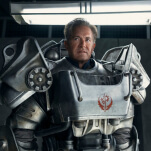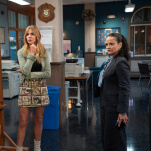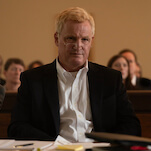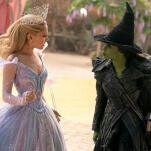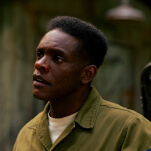Each week, Big Issues focuses on a newly released comic book of significance. This week it’s Captain Marvel #17. Written by Kelly Sue DeConnick (Avengers Assemble, Pretty Deadly) and drawn by Filipe Andrade (John Carter: A Princess Of Mars, Onslaught Unleashed), the finale of Carol Danvers’ first series as Captain Marvel is a touching tribute to the book’s fans that also features the first official appearance of the new Pakistani-American Ms. Marvel.
At their core, superheroes are inspirational figures. Even if the last 25 years have pushed these costumed characters into darker territory, their message remains one of perseverance and triumph against seemingly impossible odds. Few comics in recent memory have emphasized that theme as well as Kelly Sue DeConnick’s Captain Marvel, which has found Carol Danvers relinquishing her former Ms. Marvel identity to take on a larger role in the Marvel universe, a move that coincided with a trip through time that left the new Captain Marvel with a brain lesion that put a significant damper on her superhero lifestyle. The brain lesion is gone, but so is Carol’s memory, and her series is ending just as she’s beginning to regain her footing. Captain Marvel #17 concludes the first volume of DeConnick’s title, which will return with a new #1 and a new artist in March, and it’s an issue that rewards Carol’s immense struggle with a story about a city’s debt to its protector and a writer’s gratitude to her loyal fans.
DeConnick’s Captain Marvel series had the misfortune of debuting just a few months before the Marvel Now! publishing initiative relaunched the majority of the company’s titles, forcing it into the background as higher-profile titles flooded the shelves. Despite not being a top-selling title, it developed a passionate fan base dubbing themselves the “Carol Corps,” a group that proclaimed their love for the book on social media and at conventions, creating a community around Captain Marvel that was largely driven by female readers. Solicited as “The Carol Corps Issue,” Captain Marvel #17 is DeConnick’s thank you to a group of loyal readers that has given Marvel the faith to keep the title going, showcasing all the aspects that have made the book resonate with a group that wants to see its superheroes soar to new heights, rather than fall into darkness and despair.
The issue opens with a conversation between new character Grace Valentine and an editor at New York Beat magazine, who is bumping Grace’s piece on absolute objectivism in favor of more hopeful material surrounding New York City’s current obsession, Captain Marvel. “Post-traumatic stress is the new normal,” Ms. Blumenthal says. “No one can pull themselves up by their bootstraps… nobody has any bootstraps!” There’s a time when people need to believe in an “every man for himself” philosophy, and then there are times when people need to find hope in something bigger than themselves. In a city that barely had time to recover from a hurricane before getting an alien invasion dropped on it, hope is what will sell magazines. Grace has warped the idea of absolute objectivism to be more than just the power and potential of the individual; in her mind, if someone has the power and the potential to make others worship her, then she should be able to use that ability to make that option a reality. She’s pissed when she leaves the office, but when she finds out the city is throwing a celebration for Captain Marvel, she switches into full-on supervillain mode.
The irony of Grace’s jealousy is that Carol doesn’t even know who she is anymore. She has immense power and potential, but she doesn’t remember where it came from or what she’s supposed to do with it. Hell, she doesn’t even have a place to live anymore after being kicked out of her apartment for being a danger to her neighbors. Her Avengers teammates have been filling her in on the details of the past, but Carol is struggling to move forward without a firm understanding of the life she used to lead. Of course, that also means Carol is a blank slate with the opportunity to pave a bold new future for herself in the pages of her upcoming series debuting as part of All-New Marvel Now!, giving new readers the chance to learn about the character as she learns more about herself.
Captain Marvel #17 marks the return of artist Filipe Andrade and colorist Jordie Bellaire to this book’s creative team, bringing a sense of style that distinguishes it from other superhero titles. Andrade’s linework is heavily reminiscent of fashion illustrators like Celia Calle, with an angular, exaggerated style that isn’t necessarily the most anatomically correct, but is incredibly expressive. Andrade’s fluid line creates a beautiful sense of motion on every page, whether it’s an intimate conversation or an explosive action sequence, and he nails each emotional beat of DeConnick’s script. There are some truly breathtaking images in this issue—the splash page of Carol lifting off above the city with Kit in her arms, the shot of Carol unleashing her full power on the drones around her—and those are given more impact when contrasted with the tender moments between Carol and her friends. This issue is all about optimism and hope, and Bellaire’s bright color palette reflects that, using warm oranges and yellows to suggest that this isn’t an ending, but the beginning of a bright new day for Captain Marvel.
Carol has a strong support group to help her through her current crisis, including Kit, a young Carol lookalike who has proclaimed herself Captain Marvel’s child sidekick. Captain Marvel is the rare comic book that not only appeals to all-ages, but makes an effort to appeal specifically to young girls, giving them a character to relate to in Kit and a hero to look up to in Carol. Kit is a strong, confident child that takes inspiration from the superheroes around her to help her friends, showing how these larger-than-life characters have a legitimate affect on the attitudes of the young readers that worship them. The scene where Carol shows up at Kit’s playground is an adorable example of how the smallest actions can mean the most, as she fixes Kit’s friend’s Iron Man mask and reminds him to have pride even when bullies try to tear him down, revealing that a superhero’s power comes in many forms.
After a scene where Carol finishes packing up her apartment and takes the first real steps to romantically reconnecting with her former flame Frank Gianelli, it’s time for the Captain Marvel celebration in Times Square, which sees Mayor J. Jonah Jameson give Carol a key to the city as well as a key to her new apartment in the crown of the Statue of Liberty. That latter development is one of those great moments that is absolutely ludicrous in real life, but works wonderfully in the context of a superhero comic, even if it’s a bit foolish to publicly announce the new home of a superhero within one of the country’s most recognizable landmarks. Especially considering how easy it is for Grace to reprogram a fleet of military drones to open fire on the ceremony.
The Carol Corps comes into play in the midst of Grace’s attack, when the villainess reveals that the drones are targeting the star-shaped target on Captain Marvel’s costume. A search for “Carol Corps” on Tumblr reveals costumes, jewelry, and tattoos inspired by Captain Marvel (along with other goodies), and those fan creations serve a story purpose in this issue when the citizens of New York distract the drones with their own belongings bearing Carol’s star insignia. These people take to the streets with a unifying battle cry: “I am Captain Marvel.” Superheroes are creatures of fantasy, but they’re also external representations of the qualities within all human beings, amplified to extraordinary levels. Superman and the X-Men represent the desire to find a sense of belonging when you’re different than others, Batman and Spider-Man represent how humans cope with grief, and Green Lantern and Daredevil represent courage in the face of overwhelming fear.
Part of the reason DeConnick’s Captain Marvel resonates so heavily with female readers is that she stands for the struggle of women to be treated as equals in a society dominated by males, as evident by her relinquishing the Ms. Marvel title in favor of the formerly male Captain Marvel identity, and in this issue, Carol’s inspiration paves the way for the rise of Marvel’s newest female superhero. This week, Marvel announced the debut of a new Ms. Marvel series next February starring a Pakistani-American, 16-year-old, Muslim, Jersey Girl featuring the phenomenal creative team of award-winning writer G. Willow Wilson and artist Adrian Alphona, co-creator of the fan-favorite Runaways. Kamala Khan makes her official debut in Captain Marvel #17 (although she may have made a cameo appearance in Captain Marvel #14) as one of the bystanders at the celebration in Times Square, admiring from the ground as Carol kicks ass in the air.
The introduction of Kamala is a major step forward for Marvel; launching a new book with a non-established female superhero is already a bold decision, but the fact that Kamala is part of a minority that is grossly underrepresented in comics makes this an unprecedented move. Advance interviews suggest that Marvel is preparing for backlash, but the creative team instills a lot of faith in Ms. Marvel being far more than just tokenism at work. Wilson’s last project for Marvel, Mystic (one of The A.V. Club’s best comics of 2011), showed the writer’s keen understanding of young female characters, and Alphona’s work on Runaways’ predominantly female cast created a group of instantly memorable young women that looked like real contemporary teens. Captain Marvel #17 is the perfect place to introduce the character, as this issue focuses on the ways Carol inspires those around her. After reading this story, it’s easy to see why Kamala would want to take on her favorite hero’s former identity and make it her own.






